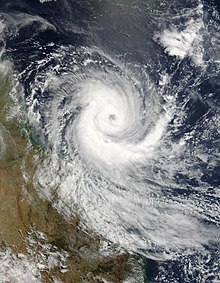
Back إعصار لاري Arabic Zyklon Larry German Ciclón Larry Spanish Cyclone Larry French Cuaranfa Larry Irish
 Larry intensifying and approaching Queensland on 19 March | |
| Meteorological history | |
|---|---|
| Formed | 18 March 2006 |
| Dissipated | 24 March 2006 |
| Category 4 severe tropical cyclone | |
| 10-minute sustained (Aus) | |
| Highest winds | 185 km/h (115 mph) |
| Lowest pressure | 935 hPa (mbar); 27.61 inHg |
| Category 4-equivalent tropical cyclone | |
| 1-minute sustained (SSHWS/JTWC) | |
| Highest winds | 215 km/h (130 mph) |
| Lowest pressure | 937 hPa (mbar); 27.67 inHg |
| Overall effects | |
| Fatalities | 1 indirect |
| Damage | $1.1 billion (2006 USD) |
| Areas affected | Far North Queensland |
| IBTrACS | |
Part of the 2005–06 South Pacific and Australian region cyclone seasons | |
Severe Tropical Cyclone Larry was a tropical cyclone that made landfall in Australia during the 2005–06 Southern Hemisphere tropical cyclone season. Larry originated as a low pressure system over the eastern Coral Sea on 16 March 2006, and was monitored by the Australian Bureau of Meteorology in Brisbane, Australia. The low-pressure area organised into a tropical cyclone two days later and quickly strengthened into a Category 4 storm on the Australian tropical cyclone scale. Larry made landfall in Far North Queensland close to Innisfail, on 20 March 2006, as a Category 5 tropical cyclone on the Australian scale, with wind gusts reaching 240 kilometres per hour (150 mph), before dissipating over land several days later.
Throughout Queensland, Cyclone Larry resulted in roughly AU$1.5 billion (US$1.1 billion) 2006 USD or AU$2 billion (US$1.55billion) 2022 USD in damage. At the time, this made Larry the costliest tropical cyclone to ever impact Australia; surpassing Cyclone Tracy in 1974 (not accounting for inflation).[1][2] In 2011, Cyclone Yasi surpassed the damage total caused by Larry.[citation needed]
- ^ David Rogers (2 February 2011). "Australia Shares End Up 0.9%; Miners Surge on Offshore Gains". The Wall Street Journal. Archived from the original on 22 May 2024. Retrieved 5 February 2011.
- ^ "Banana prices to double after crop devastation". The Age. Melbourne, Australia. 21 March 2006. Retrieved 25 March 2006.